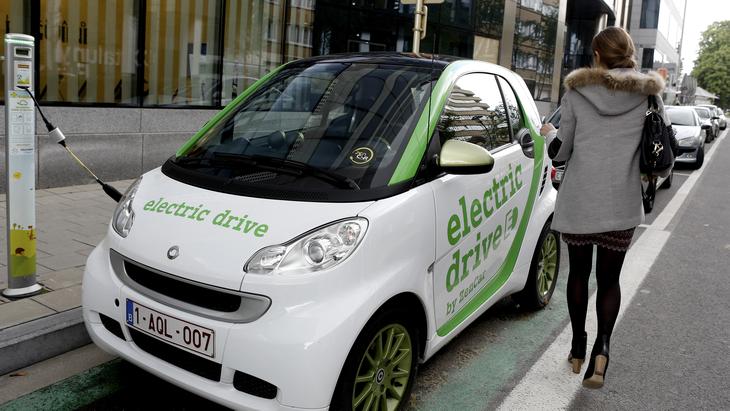Dr. Andrei David Korberg, Assistant Professor and Researcher at Aalborg University in Denmark, in the Division of Sustainable Energy Planning
In the first part of this article (in RO), we talked about the personal experience of a trip by electric car. I drove almost 5,000 kilometers from Copenhagen to Brasov and back. Besides the fact that it was a very comfortable trip, when I drew the line, I found out that in terms of energy consumption, carbon emissions and costs, the electric car was much more economical than an equivalent car on internal combustion.
These indicators become much more important when we talk about the not-too-distant future where there will be many more electric vehicles on the roads of Europe. This paradigm shift towards electromobility has positive effects for the entire energy, economic and sustainability system in general. In this sense we can look at four extremely relevant aspects related to electromobility.
Energy – electric vehicles are much more efficient
The amount of energy used for transport is one of the key factors for the complete decarbonization of the energy system. On our trip through Europe we consumed 3 times less energy than we would have consumed with a similar petrol vehicle. And that doesn’t seem very important today, when the energy source derives from oil, a distinct part of the energy system, with maximum availability depending on demand (at least technically).
But in the future where we need to replace fossil fuels with other resources of renewable origin, this is becoming very important. In this sense, electric propulsion is the most efficient solution, more efficient than hydrogen propulsion or internal combustion based on bio-fuels or electro-fuels, at least when it comes to personal cars.
The most abundant source of renewable energy is that which can be converted into electricity from wind or photovoltaic sources. However, to supply for a European car fleet (including only personal cars) with electricity from renewable sources will require large amounts of electricity, about 400-500 TWh pe annum, or the equivalent of France’s total electricity consumption. However, if the same fleet were replaced by hydrogen-powered cars, we would need more than double the renewable energy even with low energy losses or the equivalent of France and Germany’s electricity consumption combined. In the case of bio-fuels or electro-fuels, the energy requirement would be 4-5 times higher than in the case of a purely electric propulsion,
In addition, we must think that we will need renewable energy for domestic consumption, for industry or for heating homes, where electricity will replace many of the fossil fuels used today. Therefore, investing in a non-electric transmission system would put even more pressure on resources and space used to produce renewable energy. However, the resources to cover such a demand for electricity from renewable sources are sufficient, but only if we are thoughtful in how we use them.
Costs – a non-electric future in transportation would be much more expensive
The costs of a transition to electromobility are closely linked to energy. Although at first glance electric vehicles are just a more expensive version of internal combustion engines, the difference lies in the type and amount of energy used. This is because the price paid for the fuel at the pump is not representative of the amount of energy they contain and their climatic impact.
If we really paid the price for the energy they contain and the associated carbon dioxide emissions, fossil fuels should be much more expensive. Therefore, in a future where every kilogram of carbon emitted will have a cost to society, the technologies that emit the least will be the first to be used.
Hydrogen and alternative fuels for transport do not have the same low carbon footprint as electricity because they are subject to conversion from electricity/biomass to chemical energy, and then again to electricity or heat, which means losses and implicitly higher costs. Electric vehicles can use electricity directly without additional conversions and thus with greater efficiency.
Transporting and distributing one kWh of electricity is indeed more expensive than transporting one kWh of methane gas or one kWh of liquid fuel. But the fact that it eliminates most of the energy losses and conversions so that the electric motor can then turn that kWh into high-efficiency mechanical work, ultimately translates into a lower cost to society. And the lower cost occurs precisely because the costs for energy supply are substantially reduced, this being the dominant cost over the life of a car on internal combustion.
An alternative to using high-capacity batteries is electric roads. Thus, the busiest highways can be electrified, and electric vehicles can be charged on the go. Such an alternative would pave the way for the electrification of heavy vehicles as well as the use of smaller batteries. Such pilot projects have already been launched in Germany, Sweden, or Israel.
Emissions – A zero-emission road transport must be electric
Carbon dioxide emissions are directly influenced by the type of propulsion. The electric vehicle is about 3 times more efficient than an internal combustion vehicle, and this is reflected in the number of emissions generated. Thus, even in an extreme case of a fleet powered entirely by coal-fired power plants, it would generate less CO2 emissions than currently generated by internal combustion cars.
At the same time, the production of these electric vehicles is considered to be much more polluting than the production of cars on internal combustion. On the one hand, this is true, the production of batteries consumes a lot of energy. Depending on the energy mix used by the battery industry, the production process itself can become quite polluting.
However, emissions must be understood throughout the life cycle of a car, where the total carbon emissions of an electric vehicle are much lower than in the case of internal combustion. In addition, even these low emissions could be reduced to zero as the manufacturing industry adopts renewable energy technologies.
The transition to electromobility must be understood as a journey. Today, electric vehicles do not have a zero carbon footprint, but the whole process of adopting this type of mobility is a journey. Emissions will not be eliminated at first, but this is the only technology that allows a real way to use only renewable energy for transport.
Emissions are not just about CO2. Other types of emissions that can be completely eliminated with the help of electromobility are those of PM10, PM2.5 or lower particles, SOx and NOx, all elements with a harmful effect on health. Although these emissions can be reduced in internal combustion engines by means of emission cleaning systems, they cannot be completely eliminated due to combustion inside the engine.
Therefore, the complete elimination of the combustion process is a huge health benefit, as much of respiratory disease, and not only, is caused by harmful air, produced in part by internal combustion engines (in addition to other sources of emissions, such as fuels burnt for heating homes). About 8.8 million deaths are caused annually by polluted air, and among those most affected by air pollution are even children. Even the UN indicates the direct link between diesel engine emissions and cancer.
Sustainability – Is it sustainable to produce so many batteries?
As I explained above, battery production, in general, is a process with high energy consumption. In addition, the production of batteries involves the mining of resources such as lithium, cobalt or nickel. Or mining is not the most environmentally friendly, often using techniques and / or manpower that leave much to be desired. On the other hand, the production of batteries has not had the same visibility as before and, although many of the electronics used today include batteries, we have rarely been aware that the way the raw material was extracted would be unsustainable. Mining is not only dedicated to the production of batteries, and some of the extracted raw material is used in many sectors of the economy for the production of many goods and products, and even for the production of fossil fuels. For example, cobalt (used to produce batteries) is also a basic component in oil refining.
Undoubtedly, mining needs to become more sustainable. For example, the European Union can improve raw material extraction standards and relocate battery production within the Union, where it can be better controlled and regulated (much of the battery raw material is imported), while battery manufacturers have to reduce volumes and diversify the categories of materials used in the production of batteries. According to the Transport & Environment think tank, by 2030 less raw material will be needed to produce one kWh in an electric vehicle battery. That means 50% less lithium and 75% less cobalt. Some battery manufacturers have even managed to remove cobalt from batteries, and other manufacturers are preparing to produce solid state batteries,

Battery modules in preparation for recycling in Duesenfeld, Germany Credit: Wolfram Schroll / Duesenfeld
Last but not least, batteries come with the possibility of recycling, which cannot be discussed in an economy based on fossil fuels where fuels are burned. And because batteries are the most expensive part of an electric car and most likely things will stay that way, it goes without saying that they will not be “thrown away” at the end of their life cycle. From current experience, batteries still remain usable even after the end of the car’s life cycle, even if they are no longer suitable for propelling a car. They can be used to store energy, either at the home level or at the network level, when we are talking about a large number of batteries. Therefore, the chances of these batteries reaching the landfill are small. However, when they need to be recycled, the recovery rate of raw materials is high, and manufacturers and recycling companies indicate that over 90% of the materials used in the production of a lithium-ion battery can be recovered.
A successful example of recycling is that of lead-acid batteries used in internal combustion cars. Because lead is a toxic material, a standard for production and recycling has been set from the beginning, and now about 98% of batteries are recycled, even though the materials used in these batteries are cheaper than those used in electric cars. This is an example that can also be used for lithium-ion batteries in electric vehicles.
In conclusion, the transition to an electric future for transport is feasible, as long as we do it well from the beginning. This means making sure that battery production is fair, both for the environment and for the workforce involved, but also that we diversify the materials used and develop a sustainable transportation system. This means that public transport and cycling will have to take precedence over the personal car, even electric car, where possible.
Finally, I end the article with a link to a video that explains, in other words, why an electric future in transportation is a much better solution than the current model based on fossil fuels: EV or Gas, What Pollutes More?
This text first appeared on www.infoclima.ro.
